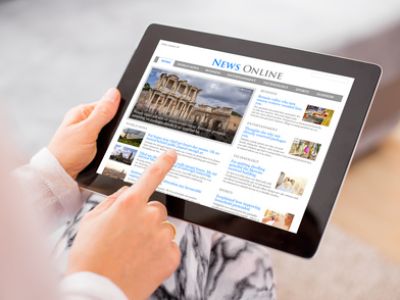Okay, so now you hopefully understand the importance of press relations. The next question is what the importance of a press release is and what the benefit of using one is. In this chapter, we’re going to be taking a look at the nature of the press release, its role in broader PR, and how you can go about it in the right way.
Why a Press Release?

Essentially, a press release is a letter that your business will write to the press, that announces some news, some event or something else newsworthy that you want covered. Again, this would commonly include news about a new product, a new service, or some kind of event or corporate shakeup. The journal or the newspaper will then cover that story for you and as a result, you’ll hopefully have your news shared with the world – or better yet – with your target audience. Hopefully, if you wrote your press release well and if you were careful in how you portrayed yourself, then that news would show your organization in a good light and ultimately help you to improve brand visibility and brand perception.
The great thing about a press release from the perspective of the originating brand, is that it offers incredible ROI. That means ‘return on investment’, meaning in other words that what you get out of the press release will significantly outweigh what you put into it.
A conference is quite a lot of work. This involves hiring out a venue (unless you have one already), making sure that the venue is attractive, and then sending out invitations to the press. Often, you’ll be expected to provide drinks or snacks and to otherwise ensure that your guests are well taken care of.
Another problem is that a press conference is only going to attract guests if your brand is newsworthy enough. Publishers and journalists have hundreds or thousands of news stories to cover and only a limited amount of space and time. If you’re Microsoft and you announce a press conference, then you can bet that journalists from every corner of the tech industry are going to come travelling from around the world to hear you speak.
ut you’re probably not Microsoft (if you are then… omigod hi!). On a very slow news day then the local paper might pop down the road to visit you, but that’s all you’re getting.
Newscenters have the same issue. Why would anyone visit your newscenter? And where are you getting the money and the staff to run one and keep it up to date?
But with a press release, things are different. With a press release, you need only release a single document that explains the news and this should be short and concise anyway. That means it won’t take you that long to write and from there, you can then deliver it to a wide range of people or you can upload it to a press release site.
If it takes, then you’ve just gained massive exposure potentially for a very tiny amount of work. And if it doesn’t? No problem – you’ve barely wasted any time at all.
Reasons for a press release

- So, the reasons that you write a press release are:
- To gain more exposure for a piece of news
- To increase general brand awareness
- To manage the public perception of your brand
- To respond to criticisms or problems
- To build your brand
- To avoid the costs and time associated with other forms of press and media relations
That’s why you release a press release.
But guess what? The press aren’t there to help you. The press do not care whether you gain exposure or not. This is not a charity.
In order to be successful, you need to start asking yourself: what is their reason for covering your news? Or more to the point, what reason can you give them?
Occasions for a press release
So what I’m trying to get at here, is that a press release should be used to provide the press or the media with news.
Remember how we said earlier that question to ask yourself is ‘who is your customer’? Well, you should also be asking ‘who is their customer’? Who is it that the press are trying to serve?
To some extent, the answer is the advertisers. But more directly, the answer is the reader. The reader is their customer and they need to get as many readers as possible in order to satisfy their other customer – the advertiser.
That means that the magazine will serve the readers. It means that the magazine will need to keep publishing content that the readers want to see. And you know what readers don’t want to see? Adverts.
I’m going to let you in on a little secret now. I am a journalist.
I’ve written for a physical magazine distributed to around 100,000 people and I’ve written for a website with millions of active readers. So, I know what journalists are looking for when they get a press release. And I know what they absolutely are not looking for.
I’m also a copywriter. That means I write ‘copy’ – writing with a purpose for a business. And if that sounds familiar, that’s because a press release is a form of copy. I exist on both sides of the equation, because I both write press releases and receive press releases.
And that puts me in a pretty good situation to tell you what you should and shouldn’t be doing when it comes to creating these documents.
The painful thing is that 99% of my copywriting clients who approach me will have zero idea how they should go about creating a press release. Yet they still give me very precise instructions.
Here is what I get very often:
“Please write a press release about our company.”
Or:

Or:
“Please write a press release telling about our 15% off deal for the first 30 customers.”
(The wonky English is there for authenticity.)
So why is this a problem? Because it’s an impossible task. Or a pointless task.
Remember, the purpose of a press release is to form the basis of an interesting article that a journalist or a media outlet is going to want to cover. That article needs to sound interesting for the audience that the paper or the website is aimed at.
So, for example, if you have a website that is all about technology and you then receive a press release about the new iPhone 13 with it’s holographic screen and little legs that allow it to follow you around… well you’re going to be overjoyed! This is exactly the kind of news you cover and it’s the perfect story to publish if you want to be seen as being up-to-date with industry news and ahead of the competition.
But what are you supposed to do with a press release ‘about our company’? Or about how a company offers the best double glazing.
That is not a story – that’s an advert.
As you write the press release, try to imagine the article that it will eventually become. What kind of article would it be if it just told people about the existence of a small company that they likely don’t care about?
“Great news! There is a small company in Oklahoma that sells shoes. The company claims that it has a commitment to the customer’s happiness. Have you ever heard a company make a statement like that? This is truly an exciting time to be someone who wears shoes…”

“Guess what! ClothesWorld.com has just announced a special offer in which – get this – you can get 30% off of all jeans. Sources close to the small store suggest that this offer will run for the next several months, but speculation is rife as to just how long the price reduction will be available. How will other stores react? Reportedly, no one will be able to beat these low, low prices. But only time will tell. What are your thoughts on this shocking breakthrough?”
Again, the point here is that the news isn’t news. This is an advert. And if your favorite magazine ran that story, you’d likely stop buying it. This could run as an advertorial perhaps (a form of advert in which a paper or magazine runs an advert but makes it look somewhat like an editorial).
So of course, they don’t run those stories. And so of course, the press release ends up being a complete waste of time for the company that wrote it.
Instead, you need to give the press a story. You need to give them an angle that will be genuinely engaging. So, let’s take a look at how this might work.
New product
The simplest news that a company will offer be able to reveal is that it has launched a new product. If you release a product, then that is potentially newsworthy for fans of that product and for people who are interested in that item.
We used this example a moment ago talking about Apple. A new product release from Apple is undoubtedly newsworthy, not only for publications that specialize in Apple or technology, but also for pretty much any news outlet. The reality is that Apple is at the point where pretty much anything it does is going to be considered news.
But the same can’t necessarily be said for any company unveiling a new product. If you are a company that sells t-shirts and you have a new t-shirt out, then you should not expect this to be newsworthy. You could try to release a press release and see if any outlets pick it up, but in all likelihood this isn’t going to be considered news by anyone that matters.

Ultimately, your product should always have a USP. If that USP is ‘U’ enough (unique), then it might be newsworthy. And in fact, you could consider this litmus test before you set out to create the product. In other words, ask yourself: how could this product be made into an exciting story? If the answer is that it could not, then reconsider it. Make something that is newsworthy. Often, thinking about marketing prior to releasing a product is a good strategy!
New services
Again, this is something that may be interesting for news if your company is big enough that people are interested in following everything you do. At the same time, it might be interesting if the service is particularly different or interesting. This will be an even harder sell than promoting a product though, in most cases!
New employees / managers
A new employee or manager isn’t news for the most part – unless that new member of staff is someone noteworthy. Let’s sty that you’re a company that has just hired a new CEO. That’s newsworthy if the company is big enough and especially if the CEO has an interesting track record and history.
Or how about if you have a new employee who is something of a superstar. When companies go about hiring new members of their team, they should think first and foremost about whether those individuals can do anything to help the organization. But following that, they may also have a think about whether that hiring could be considered newsworthy. You can hire people as a publicity stunt!
Trade fairs
Attending a trade fair can just about be newsworthy, though here the objective might be something slightly different. A trade fair, also called a trade show, is an industry event. Normally, this involves getting lots of people together who are going to promote and sell their products, recruit new employees etc. Anyone interested in the industry can go along to the show to buy products and services or to find business partners/write about the state of the industry.
If you’re attending a trade fair, then sending out a press release can be a good idea not as a way to get coverage necessarily, but potentially as a way to encourage those members of the press to come and visit you over at your stall where you can tell them more about what you do and why they should consider writing about it.
Change of location

If that robot sculpture isn’t there now, then why not get someone to build it. And why not get that someone to be a famous sculptor with a great track record? You’ve now taken a dull story and you’ve made it into something interesting and unique – therefore you’ve given yourself an excuse to send a press release. If PR is a big part of your plan going forward, then that’s how you need to start thinking!
Creation of new jobs
If you have expanded your operations in such a way that you require new members of staff, then this can be considered newsworthy for a number of reasons. For starters, it means that you’re doing something good for the economy. This is a great opportunity to improve your image and reputation by being seen as a company that is giving back and contributing.
At the same time though, this is also a great opportunity to get word out for that recruitment drive – hopefully it means that people will be on the look out for those job opportunities you’ve created.
But again, this is something of a hard sell. An industry magazine might potentially cover this if its readership is primarily made up of professionals that may be looking for work. This then comes down to making sure that your press release is seen by the right people.
But another way to think about this is as an ‘additional’ benefit you can get from a press release. In other words, if your company is expanding into new territory then that could be seen as the news. You have a new product or service, or you have a new exciting branch of your business. AND it also means the creation of new jobs. This creates more angles and gives the journalists more potential stories to run with.
Events

Social commitment / responsibility
Remember, the purpose of a press release is not just to get word out about your business but also to craft your image and to design the way you want to be seen. Ideally, most businesses will probably want to be seen in a way that makes them seem conscientious and even philanthropic. In other words, you want to be seen to give more to the world than you take – and if people think that they are helping the world by supporting you, then they will be more likely to buy from you and to support your endeavors.
Corporate anniversary
Corporate anniversaries are a fantastic opportunity to get word out about your business, to remind people that you’re still around and to help yourself get noticed. A corporate anniversary normally means that your business itself was launched on that date, or that it went public on that date.
But there are other anniversaries that you can celebrate too. For instance, you can celebrate the anniversaries of specific trade marks and IPs. This is something we see companies doing that have a major big product. Microsoft might for instance celebrate the anniversary of Windows or the Xbox. Likewise, you can even do it for characters! SEGA are constantly celebrating the 10th, 15th, 20th or 25th anniversary of their mascot Sonic the Hedgehog.
On your birthday, all focus is on you. Everyone is talking about you and you get a lot of good will. This is exactly your aim with a corporate anniversary! And not only that, but you can also use the anniversary as a way to remind people of the past and to get a little nostalgia going. Some companies might have been bigger in the past than they are in the present. Take something like Kodak. Such an organization could really take advantage of the memories many of us have for it!
Now just remember that it isn’t so much the anniversary itself that will be newsworthy as it is the things you do to celebrate. See this as an excuse to launch a party, to lunch new products, to rebrand… or to do all of the above. You can even brand the anniversary itself!
Publicity stunt

What does this mean? It could mean anything. But the term publicity stunt is generally used to describe something that is inherently a little outrageous or just very strange. So, for instance, that might mean filling a large space with bubbles, it might mean a flash dance, it might mean a parade, it might mean some kind of art exhibit… Often it involves a partnership of some kind. And ideally, it should ‘tie in’ with the brand or with your products. So, the example of the bubbles would work well for a company like O2, seeing as its logo is a bubble.
Corporate merger / partnership
A corporate merger or partnership can again be news depending on the size of your business and the nature of the merger. The most common example would be if two large companies were to team up to buy a product, or perhaps if one large company were to buy another one.
This is a subject matter that can be perceived in either a positive or a negative light. Sometimes a company acquiring another company runs the risk of the smaller company losing its identity and no longer producing the products or the services that people have come to love it for. Your job is to ensure that’s not how it is perceived!
New venture
Any new venture or new direction is news-worthy in the same ways that a new product or service is. This could be broader than just a product however, it could be an initiative, it could be a new direction and mission statement, or it could be a reaffirmation of your commitments.
Local hero

One angle to get out of this would be to have a launch party. Another would be to make your mission statement or your products and services so unique and so adventurous as to be news-worthy for that reason. But another angle you could go with is the ‘local hero’ angle.
In other words, a local paper might be interested in covering your story if they think it is relatable for others in a similar position. We do generally tend to relate to people that have a similar background to us and so hearing about how a member of the community launched their own business from nothing can be inspiring. Likewise, the same might be true for a school paper or a college magazine if you are alumni.
And in general, the story of how you launched your business can be interesting for anyone that is interested in business.
Rebranding
Finally, rebranding is also big news. Often a company will rebrand itself because it wants to change its image in some way. This might be a move for the company to distance itself from recent bad press, or just a way for it to redesign its image. Either way, this is interesting news and an interesting story that might be picked up by the press and its your job to steer the way that is interpreted. You’re redefining your image… so make sure that this new image has the best possible start!
The right time for a press release
All of these examples represent good opportunities for a press release, and so the best releases will be the ones that you announce alongside these events. Pretty much any big change in your company, your strategy or your offering can be seen as news if you pitch it in the right way and to the right people.
But of course, you also need to time precisely when you are going to unveil that news and when you are going to release the press release. And this will depend largely on the type of news. But note that most journalists do need a little time to write up their stories and they also need time for the story to go live. This is especially true for print magazines. A print magazine has the significant challenge of needing to actually publish and print its issues as well as writing the story. And many magazines will actually take over a month to do this, meaning that the magazine you read in January is very often actually filled with news and stories that were written in December or even in November.

This means you’re going to miss out on the opportunity to get covered in some of the publications that otherwise would have run your story… not good!
So, what is the alternative? Well, the simple answer is to give more advance warning. And you do this by releasing the press release but with an ‘embargo’. That means that no news outlet is allowed to cover the news until a set date (this being the ‘embargo date’). While there isn’t much you can do legally if organizations or individuals ignore this date, the generally accepted rule is that if someone breaks embargo, they then won’t be given future news to cover. This of course hurts the publication, and especially if word gets out to other organizations. As such, this is a safe way to coordinate the release of news so that it happens just when you want it.
This is also very useful for stories that inherently take more time to cover. So, for example, if you were a video game developer and you released a game, then you would likely send copies of the game to journalists and reviewers first in order to give them the opportunity to write their reviews and test the games. The embargo would then likely lift just a day or two prior to the launch of the game, at which point all those stories would go live and after which point the reviews would start appearing in print media. Either way, you’ve now gotten a whole lot of coverage right at the point when your audience will be able to soon buy the product. This enhances excitement and hopefully puts it at fever pitch just before the day.
